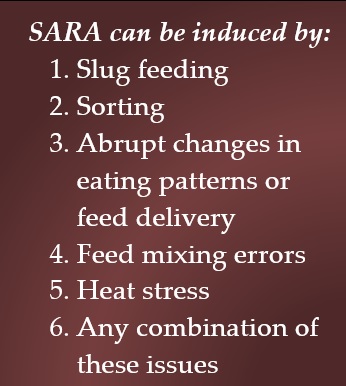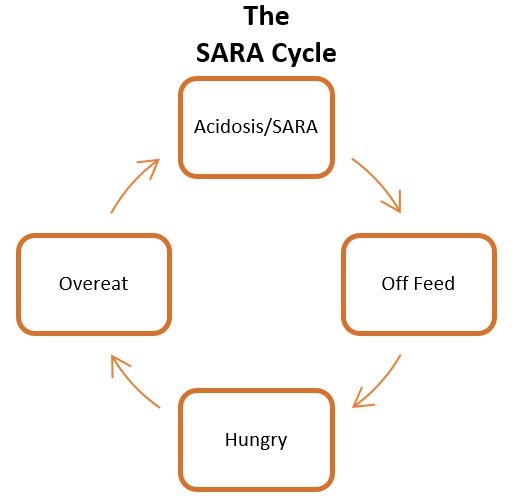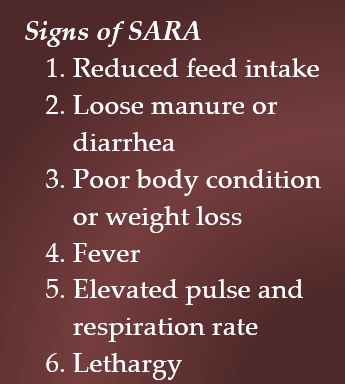Sub-acute rumen acidosis, also known as SARA, occurs when the rumen pH drops below the normal range for extended or frequent periods. Normal rumen pH run 6.0 – 7.0, while SARA occurs when the pH drops below 5.8 – 6.0 for an extended duration. After a high concentrate meal, rumen pH typically drops under 6.0 but recovers quickly. During SARA, this drop is greater and lingers for a longer period of time.
when the pH drops below 5.8 – 6.0 for an extended duration. After a high concentrate meal, rumen pH typically drops under 6.0 but recovers quickly. During SARA, this drop is greater and lingers for a longer period of time.
Essentially, any situation that leads to changes in eating behavior can lead to SARA. Repeated incidences will cause damage to the rumen environment and structures. Within the rumen, pH drops sharply due to rapid fermentation of the feed which produces large amounts of lactic acid. This gives the animal an upset stomach and backs them off feed. As the rumen empties, the rumen environment shifts dramatically causing the rumen bacteria to die off releasing endotoxins. Rapid pH changes, shifting rumen environment, and endotoxins all cause mass damage to the rumen villi (the finger-like projections that line the rumen). The villi are the structures that absorb volatile fatty acids and other nutrients. After the first SARA event, the villi will slightly harden, and the absorptive capacity will be reduced. With repeated SARA events, the villi will breakdown to less than 50% of their original size. Once the cycle begins it can be challenging to break it.
Thankfully, there are strategies to prevent or mitigate the chances of SARA becoming an issue on your facility.
- Proper feed mixing – Feed must be mixed accurately according to batch sheets and not over/undermixed.

- Timely and consistent feeding – Cattle like consistency. Feed them at the same time(s) daily. Feeding them late, allowing them to get hungry, or allowing the self-feeder to run empty can cause cattle to gorge themselves on feed inducing acidosis.
- Heat abatement – Cattle saliva contains natural buffers. In heat stress cattle begin panting and drooling, which diminishes the amount of salivary buffer reaching the rumen.
- Lick blocks – Lick blocks help promote salivation. The saliva brings the natural buffer into the rumen thus stabilizing the pH.
- Adequate water – Water is critical for proper digestion and body functions. Water should be both clean and accessible.
- Access to effective fiber – this supports rumination and increases production of saliva.
- Provide buffers – buffers can be incorporated into the diet or left out free choice. Sodium bicarbonate and sodium sesquicarbonate are both readily available options.
- Grind size of feed – in corn/pellet fed beef animals, corn should ideally be whole. Fine ground corn will cause rapid drops in rumen pH.
 If you suspect your cattle may be struggling with SARA, reach out to your Famo Feeds Representative for more targeted strategies.
If you suspect your cattle may be struggling with SARA, reach out to your Famo Feeds Representative for more targeted strategies.
Acidosis – Meet SARA
Famo Feeds • 446 Industrial Dr • Freeport, MN • 800-450-2145 |

